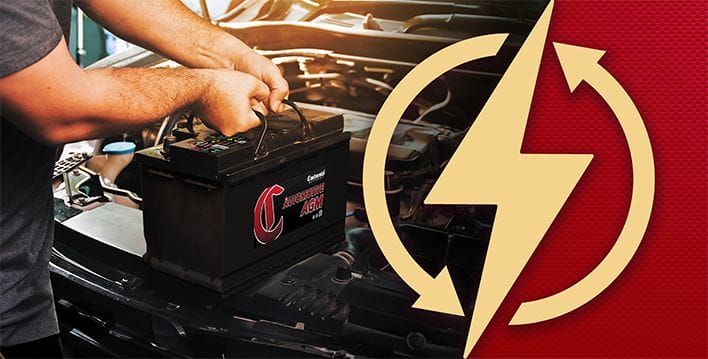
As the seasons change, it may be time to take inventory of your warehouse battery supply. Keeping the shelves stocked with batteries is important, but knowing how to store them properly is also critical. If you aren’t storing vehicle batteries correctly, they could become less efficient or damaged, harming relationships with your customers if they purchase a faulty battery.
From traditional flooded batteries to state-of-the-art lithium-ion batteries, there are many things to consider for battery storage. To give your customers batteries with maximum capacity, learn how to store batteries for all types of vehicles.
Why Battery Storage Is Important
Battery storage is crucial whether on a store’s shelves, in a warehouse or during transportation. For one, batteries can have highly flammable parts that pose a risk if they come into contact with flammable sources. Batteries also discharge over time, and if they become fully discharged — perhaps due to high heat in a storage facility or electrolytes that aren’t refilled during storage — they can become prone to buildup of lead sulfation on the interior lead plates.
Lead sulfation is a one-way ticket to a battery’s premature death. If you take a battery from storage without maintaining it and sell it to a customer, the battery could fail prematurely, leaving your customers unhappy.
On the flip side, practicing proper techniques for storing batteries can maximize their lifespan and keep your customers satisfied.
How to Store Vehicle Batteries
Storing vehicle batteries in a retail shop or warehouse requires organization and care to keep the batteries in good condition and keep your facility safe. Follow these tips for proper battery storage:
- Charge the Batteries
Make sure to store any battery type when it’s fully charged. Batteries naturally discharge over time, and if they lose too much of their capacity while in storage, they could become less efficient or permanently damaged.
To minimize this risk, charge the batteries before storing and check on their charge, recharging as needed, about every 1.5 to 3 months.
- Clean the Batteries
Dust and debris can hasten corrosion on a battery, so clean off batteries before tucking them away in storage. You can use a battery cleaning spray or a mixture of one part baking soda to 16 parts water to clean the battery terminals.
- Maintain the Right Temperature
High temperatures can cause the battery to self-discharge quickly, while cold temperatures may freeze electrolytes in flooded batteries. Ideally, you’ll want to keep batteries in a climate-controlled warehouse or storage space, where outdoor temperatures won’t impact the interior temperatures. Keep the temperature to about 40°F to 60° F and no higher than 80° F.
- Store Batteries Away From Heat, Light and Moisture
Humidity and other sources of moisture, like a flooded warehouse floor, can lead to corrosion on the batteries, so keep all battery types in a dry environment.
Heat and light sources can cause the battery to discharge faster, and it’s also important to keep batteries away from flammable sources to minimize the risk of fire. Keep batteries in well-ventilated spaces.
- Keep Batteries on Flat, Stable Surfaces
You don’t want the batteries, especially those with liquid electrolytes, to be stored sideways, at a slant or where they could be knocked over, causing harmful battery acid spillage. Instead, keep batteries on sturdy, flat shelves and make sure they aren’t at risk of falling or being bumped by anyone walking through the area.
How to Store Different Battery Types
With so many vehicles that require energy from batteries, it makes sense that there are many different battery types. While flooded batteries are the traditional and most commonly used option, you may have customers with electric or hybrid vehicles that want lithium-ion batteries or people with recreational vehicles that need maintenance-free absorbent glass mat (AGM) batteries. Depending on the battery type, batteries may have slightly different storage needs.
Flooded Batteries
Traditional lead-acid batteries, also called flooded or wet cell batteries, have electrolyte levels that need to be replenished anywhere from once a week to once a month. While stored batteries will need watering less frequently, this is still an important task to keep up with while they are in storage.
Flooded batteries, like most batteries, need to be kept in a well-ventilated space with a steady temperature of 50° to 60° Fahrenheit and away from heat sources; but what sets them apart when being stored from other battery types is the refilling process. About every three months, if not sooner, you’ll want to place flooded batteries on a flat surface and check the electrolyte level. It should be about half an inch above the lead plates and never be below the marked minimum or above the marked maximum levels.
Maintenance-Free Batteries
Maintenance-free or valve-regulated lead acid (VRLA) batteries include AGM and gel cell batteries. While these batteries still need charging and cleaning maintenance, they don’t require refilling the electrolytes. These batteries require similar storage specifications as a flooded battery, but you won’t need to worry about filling them with distilled water.
Lithium-Ion Batteries
Electric vehicles and hybrids often use lithium-ion batteries, which may have a liquid gel or paste electrolyte that reacts to a cathode and anode in the battery to discharge and recharge energy. In lithium-ion batteries, the electrolyte is highly flammable and corrosive, so storage is crucial for safety.
These batteries should be kept in a dry area, so make sure they aren’t sitting around on a workshop floor where they might get wet. The room should be well-ventilated and kept between 40° and 80° F. Because of their high flammability, this battery type needs to be kept away from sunlight, heaters and other sources of harsh heat and light.
Additionally, lithium-ion batteries shouldn’t be stacked below heavy objects and should be kept separate from other battery types.
Short-Term vs. Long-Term Battery Storage
Sometimes, you may just need to store batteries for a short term in your store’s supply area, while other times, you may have a surplus of batteries you need to keep in a larger warehouse. While there are some things to keep in mind no matter how long the batteries will be in storage, there are different tactics to use when storing batteries for the short-term vs. long-term.
Storing Batteries for the Short-Term
You may need to move some extra battery supply to your store’s backroom or warehouse for a few weeks or months. Make sure to clean and charge batteries before storing them, and check on them if they stay in storage for more than six weeks.
Storing Batteries for the Long-Term
New flooded or maintenance-free batteries can last in storage for up to two years. However, they will lose capacity over that time. Lithium-ion batteries can be stored with ongoing maintenance, like recharging, for three to five years.
Still, you should plan to rotate your stock to prevent batteries from sitting in storage for longer than six to nine months or risk shortening the batteries’ lifespans.
For long-term storage, make sure to check electrolyte levels in flooded batteries, recharge all battery types, and clean batteries every three months at a minimum to keep them at optimum capacity when it’s time to move them to the storefront.
How to Remove a Battery From Storage
A rush of customers may come in spring or fall as drivers look to replace their vehicle batteries before the harsh weather of summer or winter hits. That means it’s time to pull some batteries from storage to make sure your store shelves are stocked with products when demand peaks.
But just as you should take care to store the battery correctly, you should also follow a safety checklist before pulling batteries from storage for retail sales.
Check the Charge
Even new batteries can lose some energy when they are stored for weeks or months at a time, and you don’t want to sell a battery that won’t provide its optimal capacity and leave a customer unhappy with your products or service. Ensure the battery is fully charged before storing it, then check its voltage every six weeks to three months.
If the battery is testing under 12.4 volts, fully recharge it, as it is now only at about 30% to 40% capacity. You should recharge stored batteries if they fall below 70% while in storage.
Refill Flooded Batteries
Flooded batteries require a certain amount of electrolyte to function efficiently, so check the electrolyte level in the battery before taking it from storage. It should be about 0.5 inches above the lead plates inside the battery. You can refill the battery with distilled water, which customers will also want to do periodically with their vehicle batteries, then recharge it.
Inspect for Damage or Corrosion
You’ll want to make sure the battery is free from corrosion or other damage, like cracks or bulging, that could impact the performance and leave a customer dissatisfied. You can use a battery cleaning spray to clean off any deposits or corrosion. Check on stored batteries at least every three months.
Proper Battery Storage Leads to Satisfied Clientele
How you store vehicle batteries can make or break these products. Store them improperly, and you’ll ultimately sell low-quality goods that dissatisfy your customers. Practice proper vehicle battery storage techniques, and your clients will be sure to turn to you for all their power source needs.







